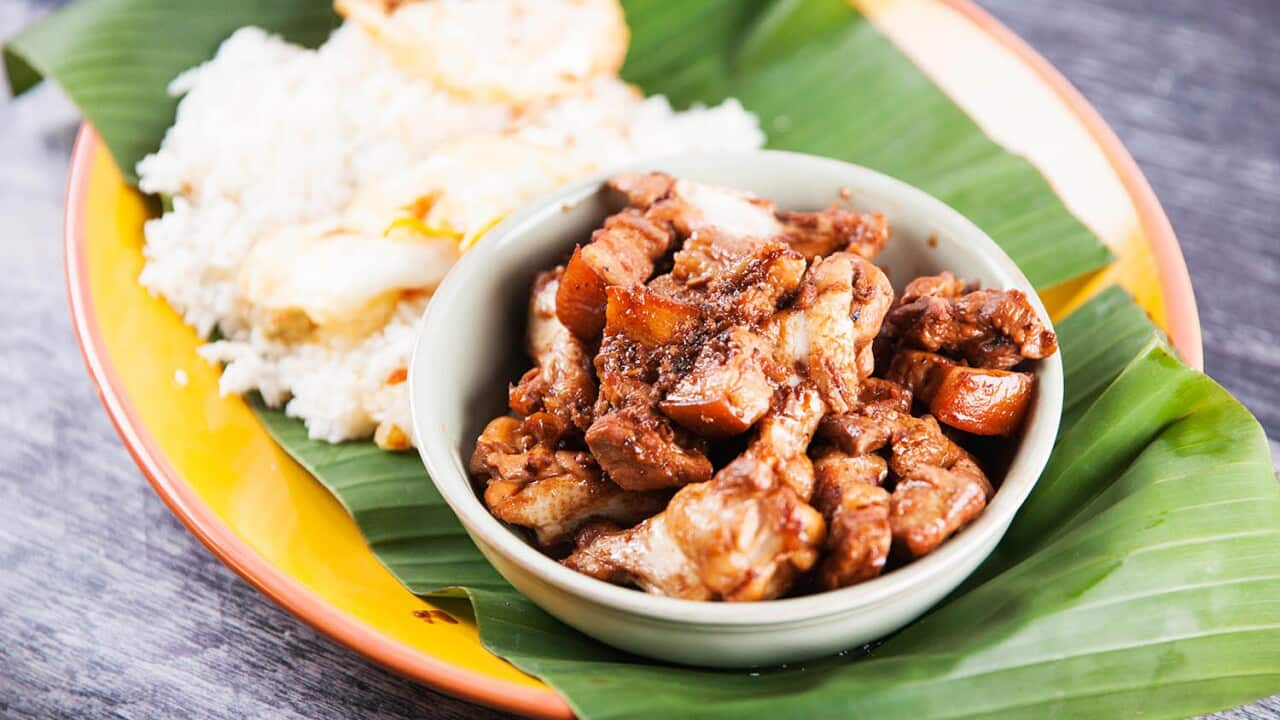I've travelled to Manila numerous times and what I love about it most, besides spending time with my relatives, is the glorious food. There's something humbling about eating food outside in the open air in sweltering heat and sitting on colourful plastic chairs that burn your backside among the resounding rhythm of revving motorbikes.
In the Philippines, I remember waking up every morning with breakfast cravings for silog, a Filipino breakfast that comprises two main ingredients: garlic fried rice (sinangag) and egg (itlog). It's also usually accompanied by a side of meat.
The egg is cracked over hot oil and blooms like a flower as it begins to bubble. From transparent to opaque white, the wispy edges begin to crisp and brown with an untouched yolk in the centre that remains soft and runny. I remember watching an old woman at the market cook eggs in a gigantic, well-seasoned, smoking wok over a roaring flame. She used a utensil to swiftly flick oil over the top of each egg to ensure the egg white was cooked all the way through. It was mesmerising to watch her cook the egg in a matter of seconds.
I remember watching an old woman at the market cook eggs in a gigantic, well-seasoned, smoking wok over a roaring flame. She used a utensil to swiftly flick oil over the top of each egg to ensure the egg white was cooked all the way through. It was mesmerising to watch her cook the egg in a matter of seconds.

Silog is a popular breakfast meal in the Philippines. Source: Melissa Fox
There was another woman packing the garlic rice into bowls and quickly turning them over onto plates, the rice resembling sandcastles in the way they kept their shape. Each fried egg was placed atop a mound of rice and the eggs drooped over the rice like floppy hats.
When cooking the garlic rice, a generous amount of garlic is chopped finely and added to the oil in a pan at low heat. By the time the garlic acquires crunch and turns golden in colour, the robust fragrance of the garlic has also infused the oil.
Cold day-old rice is then added to the garlic oil with a heavy sprinkling of salt. Rice that has been cooked and chilled the day before is preferred over freshly steamed rice. This is because the reduction of moisture in day-old rice creates a distinct chewy grain when fried, instead of the rice breaking down further and turning to mush.
The rice is then tossed around in the pan over high heat for a few minutes allowing the oil to impart flavour. The rice is ready when it has warmed all the way through and has a textural contrast of soft, fluffy grains intertwined with chewy, crisp grains.
I've travelled to Manila numerous times and what I love about it most, besides spending time with my relatives, is the glorious food.
I remember one morning visiting a restaurant in Manilla where the owners welcomed our family as though we were part of their own. They brought us different variations of silog to share. Each plate had garlic rice, a fried egg and a meat accompaniment. There was dry cured beef (tapa), sweet cured pork (tocino), salty dried fish (tuyo) and sweet spiced pork sausage (longanisa).
Naming conventions of silog slightly differ, depending on which meat is served. For example, silog with tapa is called tapsilog, and silog with longanisa is called longsilog.
At home when I'm strapped for time or don't have meat to marinate, I just eat the egg and garlic rice duo on its own, or pair it with canned meats like Spam (spamsilog) or corned beef (cornsilog), which are also common variations of the dish.
EVERY REASON TO TRY FILIPINO FOOD

Have you tried Filipino food yet? If not, now’s the time
My favourite version is tocilog, which is silog with tocino, a sweet, marinated, cured pork that is easily distinguishable by its vibrant pink colour. The thinly sliced pork is marinated and cured overnight, preferably for 24 hours if time permits. There are two steps to cooking the pork. The first is to cook the pork in water to tenderise the meat. Once the water evaporates, the second step is to drizzle with oil and fry until caramelised.
I make tocilog regularly at home and every time I eat it, the familiar flavours transport me to Manilla and back. I hope you enjoy the recipe. I recommend steaming the rice and marinating the pork the day before for the best results.
Love the story? Follow the author here: Twitter , Facebook , Instagram .
Photographs by Melissa Fox
Garlic rice, fried egg and sweet cured pork (tocilog)
Serves 4
Ingredients
Garlic rice (sinangag)
- 2 tbsp canola oil
- 6 cloves of garlic, finely chopped
- 800 g cooked white rice
- Pinch of salt
Fried egg (itlog)
- 2 tbsp canola oil
- 4 eggs
Sweet cured pork (tocino)
- 800 g pork (butt or belly), sliced into thin strips
- 3 cloves of garlic, minced
- 1 cup white sugar
- 1 tbsp salt
- ¼ tsp black pepper
- ¼ cup pineapple juice
- 2 drops of red food colouring or ½ tsp annatto powder(optional)
- ½ cup water
- 1 tbsp canola oil
Method
- Marinate the sliced pork with garlic, sugar, salt, pepper, pineapple juice and red colouring/annatto powder, and mix for a few minutes. If you are using the red food colouring/annatto powder use gloves or utensils to mix so you don't stain your hands. Let it sit and cure in the fridge overnight, or for up to 24 hours if you've got the time. The longer it's marinated, the better the flavour.
- When you're ready to cook the pork, place the marinated pork into a medium frying pan over medium heat with ½ cup of water and cook for about 15 minutes or until the water evaporates. Then, add the oil and fry for about 5 minutes until the meat caramelises.
- To make the garlic rice, pour the oil and finely chopped garlic into a large pan at low heat. When the garlic turns golden, add the rice with a sprinkling of salt and toss on high heat for a few minutes or until the rice has fried and warmed all the way through. Move the rice to a plate and use the same pan to cook the eggs.
- Pour the oil into the pan on high heat and let it heat up for 30 seconds. Crack the eggs open onto the hot oil. They should bubble up quickly. Flick the hot oil over the egg whites until they are cooked through but the yolk is still soft and runny.
- Assemble a plate with some garlic rice, a fried egg and some of the sweet cured pork, and enjoy a hearty Filipino breakfast.
SO MUCH FILIPINO FOOD

Talking TV, family adobo and Filipino mums with Michelle Vergara Moore









